5 Odd Facts About Lewis Carroll
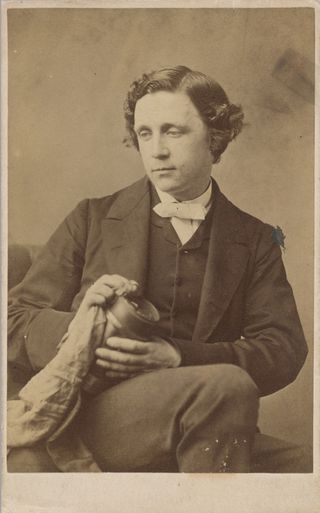
Alice fell down the famous rabbit hole 150 years ago, after family friend Charles Lutwidge Dodgson (better known by his pen name, Lewis Carroll) told the story to the Liddell sisters on a boat trip down the Thames on July 4, 1862.
Ten-year-old Alice Liddell, delighted by the tale, asked him for a written copy of the story. The rest is history. Carroll published the adventures in 1865, and the book hasn't gone out of print since.
Here are five odd facts about Lewis Carroll (1832-1898), including his enthusiasm for word games, microscopes and photography. [10 Mythical Beasts That Might Really Exist]
1. Animal inspiration
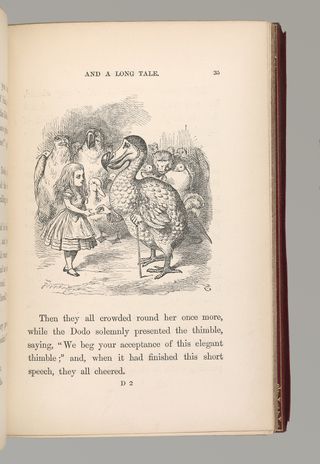
"Alice in Wonderland" is chock-full of animals, including the Cheshire cat, flamingos that serve as croquet mallets and a baby that turns into a pig. Many of the animals were anthropomorphized versions of people that Alice and her sisters knew, said Carolyn Vega, assistant curator of literary and historical manuscripts at the Morgan Library & Museum in New York City.
In one Wonderland scene, Alice runs a race in circles with a dodo and a flock of other birds and animals. The dodo is supposed to be Carroll, whom everyone knew as Mr. Dodgson. He had a stammer, and sometimes haltingly introduced himself as "Dodo-Dodgson," said Vega, who researched the book for the Morgan Library & Museum's exhibit, "Alice: 150 Years of Wonderland," which runs until Oct. 11.
Carroll frequently visited the Oxford Museum of Natural History, and likely noticed a dodo skeleton and painting on display at the museum, Vega said. Scholars speculate that this dodo inspired him when he was writing and illustrating the book.
Sign up for the Live Science daily newsletter now
Get the world’s most fascinating discoveries delivered straight to your inbox.
Alice's sisters, Lorina and Edith, are also in the race scene as a lorry and an eaglet. Robinson Duckworth, who accompanied Carroll and the girls on the boat trip, is included in the story as his namesake — a duck.
2. Microscope maven
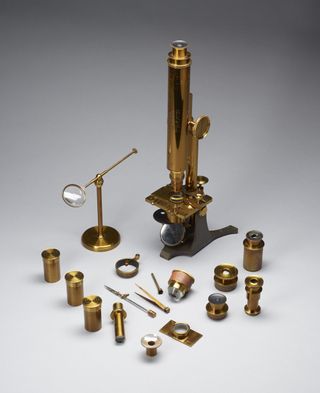
Just like modern early technology adopters, Carroll bought the latest microscope of his day. The microscope, manufactured in 1859 by Smith & Beck of London, was "something that he had for his whole life and took incredible care of," Vega told Live Science.
Carroll used the microscope to look at amoebas, other protozoa and insect larvae, according to the Morgan's exhibit. In a letter to his sister Elizabeth, he wrote, "This is a most interesting sight, as the creatures are most conveniently transparent, and you see all kinds of organs jumping about like a complicated piece of machinery … Everything goes on at railway speed, so I suppose they must be some of those insects that only live a day or two, and try to make the most of it."
Making a connection to the railway wasn't surprising for a Victorian.
"This is during the exact boon of the railway expansion across Britain," Vega said. Just as people compare concepts today to computers, people in the mid-1800s compared ideas to railroads, which was cutting-edge technology at the time, she said. [Science in 'Alice's Adventures in Wonderland' (Infographic)]
3. Word and logic games
Wonderland may be an absurd place, but it's surprisingly logical at times. Perhaps that's because Carroll, who taught mathematics for 26 years at Christ Church at the University of Oxford, infused logic into his writing and games.
In "Syzygies," a game Carroll created, players change letters in one word to make another. For example, walrus; peruse; harper; carpenter. Try the challenge here (answers below).
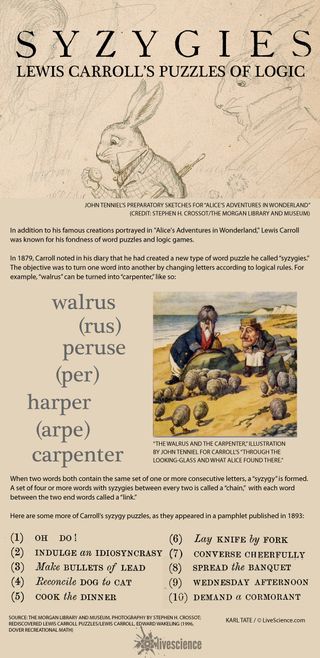
4. Lierary breakthrough
Many children's books in the 1800s taught morals or lessons. Not Alice.
"It's not that Alice isn't a good role model and inspiring, and it's not that she doesn't behave morally and ethically," Vega said. "But it doesn't conclude with a didactic statement."
Carroll makes fun of moralistic poetry, and his parodies are sprinkled throughout the book. For instance, the poem, "You are old, Father William" spoofs the poet Robert Southey's, "The Old Man's Comforts, and How He Gained Them," writing about a silly, instead of a sage old man imparting wisdom to a youth.
After reading "Wonderland," the English artist Dante Gabriel Rossetti wrote a letter to Carroll, saying that the Father William ballad was "among the funniest things I have seen for a long while."
Carroll's writings helped set the stage for later children's books, especially novels that were meant to entertain and delight children, instead of pedantically review lessons, Vega said.
5. Questionable photography
Carroll took about 3,000 photos during his lifetime. He began his hobby by snapping shots of landscapes and cathedrals but later focused on portraits and scientific specimens, Vega said.
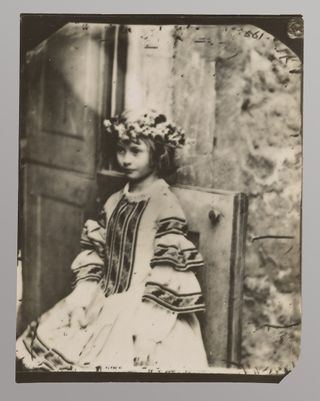
Some of his photos give modern scholars pause. In two photos framed side by side that he gave to the Liddell family, he used Alice as a model to show the contrast of her dressed in Victorian finery next to a photo of her dressed as a beggar child. The beggar photo looks suggestive, with her tattered dress falling off her shoulders.
"It's unavoidable and true that this photograph, in particular, has led to decades of speculation about Carroll's true feelings for Alice," Vega said.
In 1863, his relations with the Liddell family cooled, but it's not clear why; one of his relatives removed the pages of Carroll's journal from that time period, Vega said.
Carroll also took several nude photos of children, but these were taken with parental permission, Vega said. Though it seems odd by today's standards, it wasn't uncommon during the mid-1800s.
"Victorians considered children to be symbols of pure innocence, and being around them was to be a little closer to grace," Vega said. "That is, the symbol of the nude child in art had a different place in the Victorian world than it does today."
However, researchers found other incriminatory evidence against Carroll. The BBC program "The Secret World of Lewis Carroll," which aired in January, reviews a photo found in a French museum that experts credit to Carroll. In the photo, Alice's sister Lorina poses nude in a suggestive posture. What's more, Alice's descendants have heard rumors of his peculiar relationship with the girls.
"My understanding is that he was in love with Alice, but he was so repressed that he never would have transgressed any boundaries," Vanessa Tait, the great-granddaughter of Alice Liddell, told The Telegraph.
Carroll was a "strange man, but an admirable one, and I don't want to tar him with accusations of pedophilia, which we're all so obsessed with now," Tait told The Telegraph. "It's sad that that's the thing everyone is going to want to know, especially in the year of the anniversary of the book.”
Answers
- Oh Do: Oh (oh); Cohere (ere); Reredos (do); Do
- Indulge an Idiosyncrasy: Indulge (ndu); Unduly (duly); Incredulity (incr); Idiosyncrasy
- Make Bullets of Lead: Lead (lea); Plea (ple); Sample (sam); Jetsam (ets); Bullets
- Reconcile Dog to Cat: Dog (dog); Endogen (gen); Gentry (ntry); Intricate (cat); Cat
- Cook the Dinner: Cook (coo); Scooping (pin); Pinned (inne); Dinner
- Lay Knife by Fork: Knife (nife); Manifest (man); Workman (ork); Fork
- Converse Cheerfully: Converse (erse); Persevering (erin); Merino (meri); Perfumery (erfu); Cheerfully
- Spread the Banquet: Spread (read); Readiness (ine); Shines (shin); Vanquishing (anqu); Banquet
- Wednesday Afternoon: Wednesday (ednes); Blessedness (esse); Fitnesse (iness); Craftiness (raft); Rafter (after); Afternoon
- Demand a Cormorant: Demand (eman); Gentleman (gent); Tangent (ange); Orange (oran); Cormorant
Follow Laura Geggel on Twitter @LauraGeggel. Follow Live Science @livescience, Facebook & Google+. Original article on Live Science.

Laura is the archaeology and Life's Little Mysteries editor at Live Science. She also reports on general science, including paleontology. Her work has appeared in The New York Times, Scholastic, Popular Science and Spectrum, a site on autism research. She has won multiple awards from the Society of Professional Journalists and the Washington Newspaper Publishers Association for her reporting at a weekly newspaper near Seattle. Laura holds a bachelor's degree in English literature and psychology from Washington University in St. Louis and a master's degree in science writing from NYU.